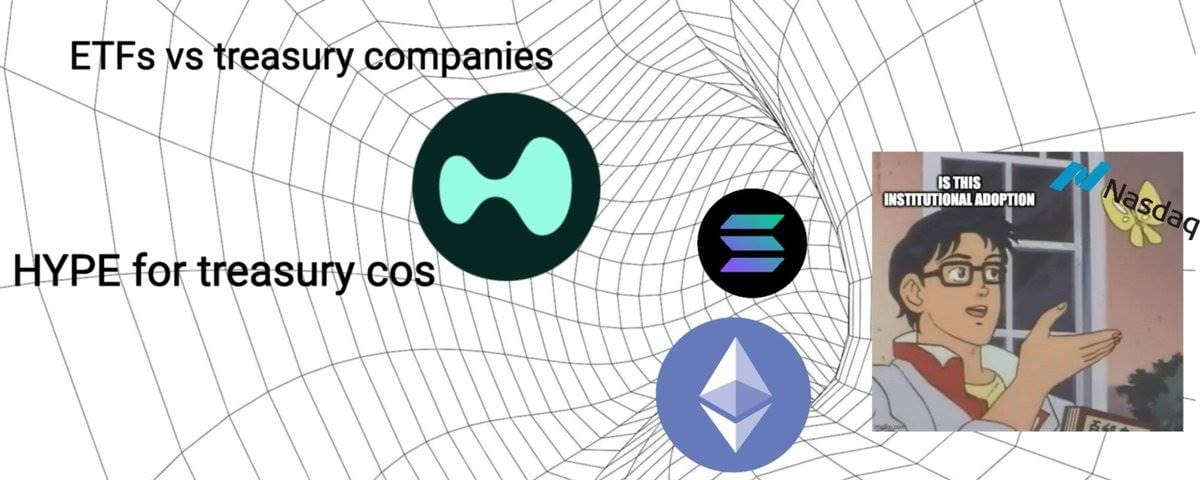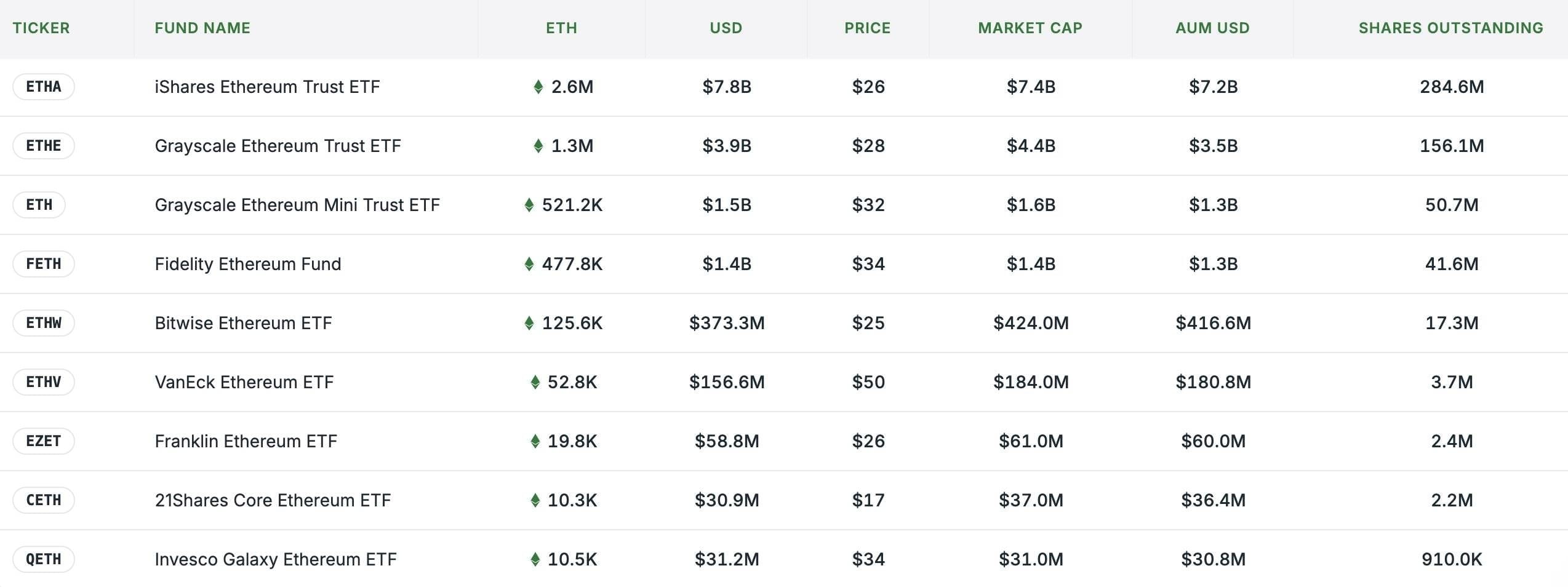Author: Jesse
Compiled by: Deep Tide TechFlow

I wrote an article about cryptocurrency asset management companies earlier this month. If you are not familiar with this topic, I suggest you read that article first, as it builds on most of the same concepts.
The trend of cryptocurrency asset management companies represents a shift in the way capital flows on-chain (or how value created on-chain is directed to investors).
The more these companies invest in other altcoins (just last week, we acquired TAO and Litecoin), the more the market bubble seems to grow. However, public company participation in the ecosystem or other on-chain applications may bring some value, at least for some of the highest quality assets in the cryptocurrency field.
This article covers the following points:
The flexibility and marketability of cryptocurrency asset management companies make them superior to ETFs
Cryptocurrency asset management companies are the ultimate form of institutional crypto, aligning investors' sales with technology adoption.
In many cases, relying solely on treasury reserve models is insufficient; teams must balance the ability to build asset financing with the ability to extract asset value through DeFi or other infrastructures.
Hyperliquid is particularly well-suited for this trend, as its ecosystem may be more attractive compared to Ethereum or Solana.
Asset Management Companies vs. ETFs
Asset management companies are clearly the ideal choice when investors have no other options, but do they still make sense if there are other alternatives (such as ETFs)?
The listing of ETFs does not mean the demise of asset management companies. ETFs must be sold like other investment products; the more popular and accessible the asset, the stronger the product's competitiveness. Therefore, the competition of ETFs ultimately heavily relies on trust or relationships rather than actual management advantages. For many investors, simple asset exposure from familiar brands may be more favored. Recently, there has been a high demand for Ethereum ETFs, with the total holdings nearing 5 million ETH:

That is to say, for specific cryptocurrency assets, asset management companies may be better than ETFs:
They can reach a broader variety of investor types; many investors may not be allowed to purchase ETFs or may prefer to invest in fixed income, stocks, convertible bonds, etc. Asset management companies can build trades targeting these types of investors.
Asset management companies can maximize the productivity of core assets, creating value for shareholders—meaning that, compared to waiting for ETH staking ETFs to be approved, asset management companies can freely stake ETH directly.
That is why, despite there being multiple ETFs for ETH, the amount of ETH accumulated by @BitMNR($BMNR) and @SharpLinkGaming($SBET) has already surpassed that of many ETFs (both of which are sized between the aforementioned Bitwise and Fidelity). The amount of ETH they are currently accumulating also exceeds that of the Ethereum Foundation:

The second point is crucial for every fund management company, as the best companies are deeply integrating into DeFi. Currently, the frontrunners appear to be Sharplink in the Ethereum space and @defidevcorp ($DFDV) in the Solana space. By name, DFDV clearly indicates its positioning, while Sharplink directly promotes Ethereum as 'DeFi on Nasdaq.'
Original link to tweet: Click here
Ecosystem Asset Management Company: A New Form of Institutional Cryptocurrency
Companies investing in and utilizing native assets or DeFi infrastructure are close to the ultimate form of institutional cryptocurrency adoption.
Previously, institutional entry into the crypto space could be divided into two paths: investment (such as Grayscale's products or via funds) and technology application/adoption (such as corporate blockchain or L2 payment collaborations). Nowadays, entities holding blockchain tokens are starting to actually use these tokens.
Companies with cryptocurrency fund management businesses are also the ultimate regulatory arbitrage tool between traditional finance and cryptocurrency finance. Previously, pools of funds that needed regulated counterparties could utilize fund management companies as operational tools for DeFi yields or other demands (to some extent, fund management companies using DeFi can replace the role of investment banks).
We have seen asset or region-specific asset management companies:
Original tweet link: Click here
However, we have yet to see them expand their service offerings beyond merely operating infrastructures or staking underlying assets for returns. I would not be surprised if an operating company successfully scales the application of RWA to DeFi or if they are used as vehicles to cross previously fragmented pools of funds through DeFi.
The Special Case of HYPE
For mature assets, the discussion about ETFs and fund companies should reflect the trends we see in the market. The model is roughly as follows:
ETF listings and/or asset management company financing → Each new company needs differentiation → They are pushed onto the chain to pursue returns → The acquisition of tokens is no longer a differentiating factor; asset utility and DeFi profitability are the most important factors.
This leads companies to prefer investing in tokens that can secure higher quality, sustainable returns. For most assets where economic value occurs on-chain, such as ETH and SOL, companies can devise strategies around how to acquire value. (Conversely, it is difficult to understand how or why a company lacking revenue opportunities could survive long-term.)
This is very favorable for HYPE as an asset management company asset, as this token is closely related to the value generated by its product usage. The fees charged to traders on Hyperliquid accumulate and are used to periodically repurchase HYPE tokens from the market. This is also the most direct benefit for investors, aside from the more nuanced mechanisms of HYPE's value.
For equity holders of asset management companies, this provides a strong rationale for choosing to hold an asset that generates dividend flows through cryptocurrency trading activities (and in a tax-advantaged manner) for the long term.
But another key reason HYPE provides a case for asset management companies is that, in addition to adopting core DEXs, the development level of asset management companies is still not sufficient.
Compared to other assets, HYPE has very little institutional presence, and the core DeFi protocols of the ecosystem are just beginning to launch and gain attention.
For today's asset management companies, the first point is the most important. Previous discussions about ETFs particularly support the case for HYPE. However, Hyperliquid ETFs seem unlikely to become the primary way for institutions to invest in HYPE, especially considering the early appeal of companies focused on HYPE (such as @HyperionDeFi, @HYLQstrategy, and @SonnetBio). Additionally, ETFs need to fund liquidity, most of which has already flowed to these asset management companies. This may be one of the biggest differences between institutional entry into the market and market demand.
If a company can become a steward of the ecosystem, rather than just provide asset exposure for traditional investors, then this opportunity becomes more attractive. The Hyperliquid ecosystem is still in its early stages of development, which provides an open opportunity for a company to become a key participant in the design/operation of DeFi protocols and infrastructure.
We have seen this phenomenon in the market: the launch of @kinetiq_xyz LST has been split into a special procurement for asset management company partners, HYPE (iHYPE).
Original tweet link: Click here
In addition to product design or development, the company may also invest in early protocols within the ecosystem. This is also a great complement for companies in the process of raising funds, as they can sell exposure to underlying assets, operate infrastructure for the ecosystem, and provide investors with venture-like returns.
This contrasts with the following situation: $SBET and DeFi protocols: While they hold more ETH than the Ethereum Foundation, the underlying DeFi they use may have become rigid or managed by a DAO. For example, Lido's staking has already expanded for institutional users. New asset management entities are unlikely to become design partners for the new Lido. ETH staking remains profitable, but its agency mechanism is lower compared to co-building with the next Lido, which is closer to the reality of ultra-liquid asset management.
In any case, the further a company is from the underlying DeFi protocols they use, the less opportunity they have to acquire value. This also explains why DFDV is promoting a franchise model, where they own the underlying infrastructure of other companies in various regions to build brands and raise funds to purchase SOL.
Summary
Most token asset management companies will not receive a premium during bear markets, while companies that do have competing common assets will need to delve deeper into the ecosystem to demonstrate that they indeed provide unique value.
From this perspective, power laws (note: in power law distributions, the probability of the occurrence of most events is low, while the probability of a very small number of events is high) may benefit some companies focused on specific assets. Companies that cannot fully grasp the non-cryptocurrency native demands will need to turn to other assets or on-chain activities. If they cannot do this, their failure modes may differ greatly depending on the company and the asset, which may be worth exploring in another article.



